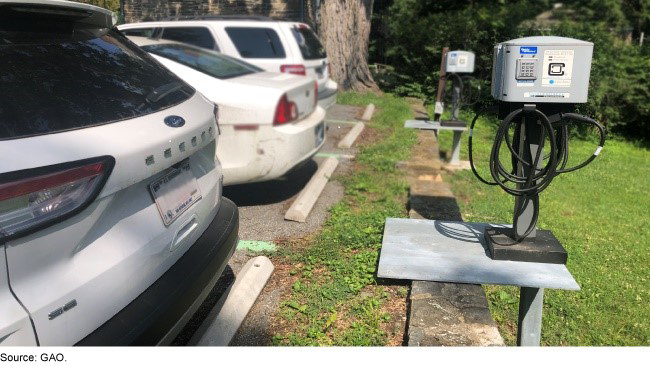Federal Fleets: Zero-Emission Vehicle Implementation
Fast Facts
In December 2021, the Biden Administration issued an Executive Order calling for most federal vehicle acquisitions to be zero-emission vehicles by 2035. This Q&A discusses the progress agencies have made toward meeting this requirement.
Most of the 30 affected agencies have started preparing their workforces and set annual goals for installing charging equipment and acquiring vehicles. This fiscal year, 26 agencies set a target to install 8,500 charging ports and acquire nearly 9,500 zero-emission vehicles.
Some ongoing challenges include limited vehicle availability, costs, and limits on the capacity to charge vehicles at federal facilities.

Highlights
What GAO Found
The transition to zero-emission vehicles (ZEVs) will require a significant transformation in the federal government's approach to vehicle procurement. GAO found that federal agencies have taken the initial steps toward implementing these types of vehicles into their fleets. A zero-emission vehicle is any vehicle, such as an electric vehicle, that produces zero tailpipe exhaust emissions of certain pollutants or greenhouse gases when operating. The Administration's Federal Sustainability Plan outlined actions to help agencies navigate this transition. These actions include, among others, (1) improving the federal workforce's understanding of ZEVs, (2) optimizing the fleet management, and (3) expanding charging infrastructure at federal facilities.
As with any new technology, lack of knowledge and experience can hinder adoption, and agencies have generally established teams to manage their ZEV transitions and plan to take steps to address any gaps in their technical expertise. GAO found that agencies generally plan to offer a variety of resources to their employees, including training developed by the Department of Energy (DOE) and the General Services Administration (GSA), ranging from seminars to gain familiarity with the vehicles to more complex trainings on combatting cybersecurity threats. Some agencies also described the use of pilot programs, small scale roll-outs, and other technical demonstrations to engage employees and build confidence in their workforce regarding the understanding and use of ZEVs.
GAO found that agencies have also taken, or plan to take, the first steps to adopt new, or update existing fleet management practices, in an effort to accelerate ZEV deployments. Specifically, agencies have conducted initial fleet assessments to predict the level of electrification generally achievable given their current fleet profile. After completing this assessment, agencies set targets to acquire almost 9,500 light-duty ZEVs in fiscal year 2023—mostly sport utility vehicles (SUVs), pick-up trucks, and sedans. Agencies, however, reported two key challenges related to the acquisition of these vehicles—limitations in the numbers and types of vehicles available.
While agencies wait for more ZEV availability, many agencies have prioritized expanding their charging equipment infrastructure, according to officials from the Council on Environmental Quality (CEQ). GAO found that agencies have begun to conduct site assessments at a limited number of federal facilities. These assessments, which review planned acquisitions, parking locations, and electrical infrastructure, can help inform recommendations for the numbers, types, and locations of the charging equipment necessary to support the fleet in the coming years. In fiscal year 2022, agencies initiated almost 550 site assessments—this includes designing the assessment or researching pricing—and plan to conduct an additional 1,781 assessments. Agencies, however, reported three key challenges that may hinder the installation of charging equipment at federal facilities—electrical capacity limitations, costs, and leased space.
Why GAO Did This Study
In December 2021, the Biden Administration issued an Executive Order calling for federal vehicle acquisitions to be zero-emission vehicles, such as electric vehicles, by 2035, including 100 percent zero-emission light-duty vehicle acquisitions beginning in 2027. This order affects approximately 380,000 vehicles within federal fleets as they become subject to replacement. Electrifying these fleets represents a significant transformation in the federal government's approach to vehicle procurement and will require a shift in perceptions about their capability to adequately meet mission needs in terms of performance and driving range. As agencies move forward with their transition to ZEVs, CEQ, the Office of Management and Budget, GSA, and DOE play an integral role in providing leadership and helping agencies to meet applicable fleet energy requirements, such as those set forth in the Executive Order.
GAO was asked to examine key considerations of the federal transition to ZEVs. This report examines: (1) steps agencies have taken, or plan to take, to prepare the federal workforce for ZEVs (2) steps agencies have taken, or plan to take, to optimize their fleet management, and (3) steps agencies have taken, or plan to take, to expand charging equipment at federal facilities, among other objectives. GAO reviewed the Zero-Emission Vehicle Fleet Strategic Plans of 26 agencies—these plans outline agency's fleet transition strategies (for those with at least 20 vehicles) to understand future acquisition and installation targets, estimated budget requirements, potential challenges, and lessons learned. As of March 2023, 26 of 30 plans had been approved by CEQ and OMB, and these 26 agencies represent over 99 percent of all vehicles within federal fleets. GAO also interviewed officials from four selected agencies the Department of Homeland Security (DHS), the Environmental Protection Agency (EPA), the Department of Transportation (DOT), and the United States Department of Agriculture (USDA) on the steps they have taken to integrate ZEVs into their fleets.
For more information, contact Catina Latham at (202) 512-4800 or LathamC@gao.gov.
